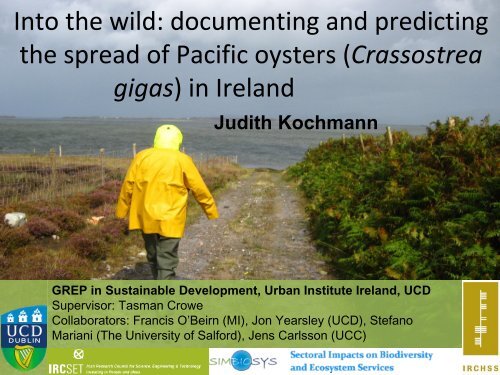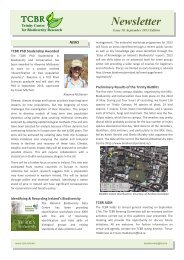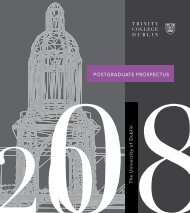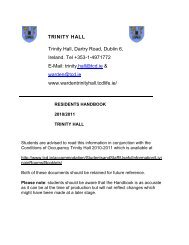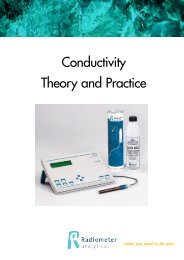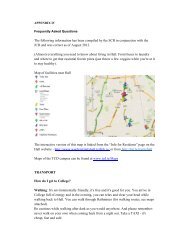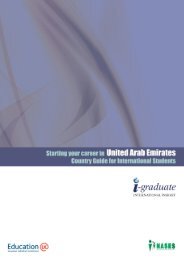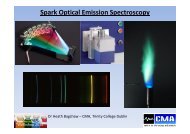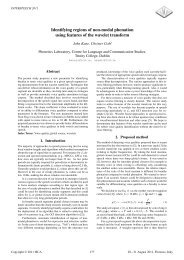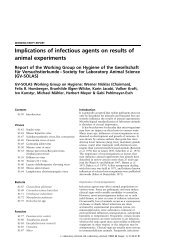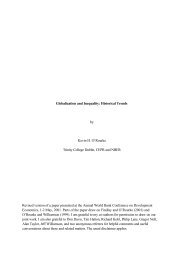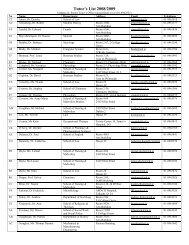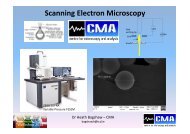in Ireland
in Ireland
in Ireland
You also want an ePaper? Increase the reach of your titles
YUMPU automatically turns print PDFs into web optimized ePapers that Google loves.
Into the wild: document<strong>in</strong>g and predict<strong>in</strong>g<br />
the spread of Pacific oysters (Crassostrea<br />
gigas) <strong>in</strong> <strong>Ireland</strong><br />
Judith Kochmann<br />
GREP <strong>in</strong> Susta<strong>in</strong>able Development, Urban Institute <strong>Ireland</strong>, UCD<br />
Supervisor: Tasman Crowe<br />
Collaborators: Francis O’Beirn (MI), Jon Yearsley (UCD), Stefano<br />
Mariani (The University of Salford), Jens Carlsson (UCC)
Influences of aquaculture on ecosystems<br />
• Interactions with wild‐fisheries resources<br />
• capture of seed mussels<br />
• fish capture for feed production<br />
• Physical changes to the habitat<br />
• addition of structures<br />
• Organic and nutrient enrichment<br />
• Invasive species<br />
• Vectors, escapes, facilitation<br />
• Interactions with seals and birds<br />
• positive and negative<br />
photo: Valdimar Ingi Gunnarsson
<strong>Ireland</strong><br />
• One of the three ma<strong>in</strong> aquaculture species <strong>in</strong> <strong>Ireland</strong> is<br />
the Pacific oyster<br />
• Pacific oysters cultured on <strong>in</strong>tertidal trestles s<strong>in</strong>ce<br />
early 1970`s<br />
• 6‐7 k tonnes produced <strong>in</strong> 2007, valued €15 million
Pacific oyster<br />
1950`s<br />
1960`s<br />
1920`s<br />
• Shell length of 30‐40 cm,<br />
up to 1 kg live wet weight
Range of impacts<br />
• Invasive populations <strong>in</strong> many parts of the world<br />
significant changes on ecosystems:<br />
with<br />
• decrease carry<strong>in</strong>g capacity, especially of aquaculture<br />
bays<br />
• native mussels show reduced growth between<br />
oysters<br />
• act as a vector for other non‐native species<br />
• Most obvious and significant change is change of<br />
habitat structure
Shift from mussel beds to oyster reefs <strong>in</strong> the Wadden<br />
Sea<br />
Oyster reef<br />
Blue mussel bed
Pacific oyster <strong>in</strong><br />
• Thought not to be able to reproduce <strong>in</strong> <strong>Ireland</strong><br />
• Some <strong>in</strong>dividuals observed outside aquaculture<br />
• Extent of feral populations not known
Aims<br />
• Aim 1 Characterise the distribution and abundance of<br />
Pacific oysters <strong>in</strong> <strong>Ireland</strong> – observational approach<br />
• Aim 2 Test the <strong>in</strong>fluence of relevant factors on survival<br />
and growth of oysters – experimental approach<br />
• Aim 3 Comparison of genetic structure between feral<br />
and aquaculture oyster populations ‐ molecular tools
Aim<br />
1<br />
• Aim 1: Characterise the distribution and abundance of<br />
Pacific oysters <strong>in</strong> <strong>Ireland</strong><br />
‣ Assess the current range and status of Pacific oysters<br />
<strong>in</strong> <strong>Ireland</strong><br />
‣ Identify ma<strong>in</strong> factors associated with the<br />
presence/absence of oysters – observational<br />
approach
Sampl<strong>in</strong>g Design<br />
• 2009 sampl<strong>in</strong>g programme<br />
undertaken together with Mar<strong>in</strong>e<br />
Institute, Lough’s Agency, Queen’s<br />
University Belfast, BIM<br />
• Repeatable, cost effective protocol<br />
developed<br />
• Semi‐quantitative assessment of<br />
abundance and habitat types at all<br />
sites (SACFOR, EUNIS framework)<br />
• Quantitative transects to assess<br />
maximal densities and small‐scale<br />
habitat associations
Distribution and abundance<br />
• Oysters were found at<br />
18 out of 69 sites visited<br />
• Transect results:<br />
• Lough Swilly, rocky shore:<br />
6.3 <strong>in</strong>d/m 2<br />
• Lough Foyle, mussel bed:<br />
5.4 <strong>in</strong>d./m 2<br />
• Shannon Estuary, rocky<br />
shore: 0.7 <strong>in</strong>d./m 2<br />
common<br />
frequent<br />
occasional<br />
rare<br />
absent
Size frequencies<br />
• Sizes ranged from 25 –135 mm <strong>in</strong>dicat<strong>in</strong>g several<br />
recruitment events
Environmental factors<br />
• Probability of oyster presence was assessed as a function<br />
of variables us<strong>in</strong>g logistic regression and stepwise model<br />
selection (AIC)<br />
• Factors expla<strong>in</strong><strong>in</strong>g oyster presence best:<br />
Aquaculture present<br />
but > 500 m;<br />
p = 0.035<br />
Residence time;<br />
p = 0.001<br />
Hard substrate and<br />
biogenic reef;<br />
p = 0.002<br />
Shore width > 50 m;<br />
p = 0.010
Aim 2<br />
• Aim 2: Test the <strong>in</strong>fluence of relevant factors on survival<br />
and growth of oysters –experimental approach<br />
Macroalgae<br />
•Modify flow, affect<strong>in</strong>g<br />
sediment (‐) or food (+)<br />
•Smother and <strong>in</strong>terfere<br />
with filter apparatus<br />
Predators<br />
•Consume juvenile stages<br />
Interaction<br />
•Macroalgae may <strong>in</strong>crease <strong>in</strong>fluence of predation<br />
by provid<strong>in</strong>g habitat for predators
Aim 2<br />
10 <strong>in</strong>dividuals per tile<br />
1. Macroalgae<br />
2. Predation<br />
No cage Cage control Cage No cage Cage control<br />
Cage<br />
Replicated at 2 sites
Results ‐ survival<br />
•Strong effect of predation <strong>in</strong> pilot study July<br />
2010, mean oysters size 16 mm
• effect of predation absent <strong>in</strong> September 2011,<br />
mean oysters size 36 mm
Results ‐ growth<br />
*<br />
*<br />
*<br />
*<br />
*<br />
• Significant larger growth (*) without macroalgae<br />
R<strong>in</strong>ville<br />
<strong>in</strong>
Results ‐ growth<br />
*<br />
*<br />
• Opposite pattern, but not significant<br />
• Condition <strong>in</strong>dex May 2012 (DTW*1000/DSW)<br />
no significant effect of macroalgae
Aim 3<br />
• Aim 3: Comparison of genetic structure between feral<br />
and aquaculture oyster populations<br />
‣ Establish whether oysters outside aquaculture are form<strong>in</strong>g<br />
self‐susta<strong>in</strong><strong>in</strong>g populations or are the result of repeated<br />
spawn<strong>in</strong>g from aquaculture<br />
1 Bay<br />
2 Populations<br />
3 Size classes<br />
14 Microsatellites
Results<br />
• Evidence for the uncoupl<strong>in</strong>g of aquaculture and feral<br />
populations<br />
• Self‐recruitment of feral populations likely<br />
Genetic evidence for the uncoupl<strong>in</strong>g of local aquaculture activities and a population of an <strong>in</strong>vasive species –a case<br />
study of Pacific oysters (Crassostrea gigas) by J Kochmann, J Carlsson, T P Crowe, S Mariani (accepted by Journal of<br />
Heredity)
Summary<br />
• Pacific oysters are established <strong>in</strong> <strong>Ireland</strong> and most likely<br />
self‐recruit<strong>in</strong>g<br />
• No dense reefs <strong>in</strong> the <strong>in</strong>tertidal<br />
• Several cohorts present and new recruits found <strong>in</strong> 2011<br />
• Occurrences known from shallow subtidal native oyster<br />
beds (report by Mar<strong>in</strong>e Institute and BIM 2011)<br />
• 5.64 million feral Pacific oysters estimated for Lough Swilly <strong>in</strong><br />
<strong>in</strong>tertidal/subtidal habitats
Summary<br />
• Oyster presence strongly associated with hard<br />
substrata and biogenic reef, long residence times<br />
of embayments and large <strong>in</strong>tertidal areas<br />
• Macroalgae and predators can <strong>in</strong>fluence growth<br />
and survival, but effects vary
Summary<br />
• Although feral oysters can be demographically<br />
uncoupled from closest aquaculture, further sampl<strong>in</strong>g<br />
of bays without aquaculture is needed to characterise<br />
the association of aquaculture more fully<br />
• Sampl<strong>in</strong>g protocol provides a basel<strong>in</strong>e and repeatable<br />
method for future sampl<strong>in</strong>g by state agencies<br />
• Comb<strong>in</strong>ation of coord<strong>in</strong>ated sampl<strong>in</strong>g, experiments<br />
and molecular tools can help to identify factors<br />
associated with spread of oysters and <strong>in</strong>form strategies<br />
for adaptation and control
Thank you for your attention!
Acknowledgements<br />
HELP and ADVICE<br />
• Tasman Crowe<br />
• Francis O’Beirn<br />
• Jon Yearsley<br />
• Stefano Mariani and Jens Carlsson<br />
• Ciarán McGonigle, Loughs Agency<br />
• Gra<strong>in</strong>ne O’Brien & regional officers, BIM<br />
• Heike Büttger, BioConsult, Germany<br />
• Claire Guy & Dai Roberts, Queen’s University<br />
Belfast<br />
FIELD/LAB WORK<br />
• Jen Coughlan, Rónán Mag Aoidh, Tomasz Dabrowski, Mike Burrows, Sarah Burke, Paul Brooks, Cather<strong>in</strong>e<br />
Butler, Myriam Callier, Mave Cavanagh, Mozart Fazito, Vangelis & Panagiotis Giannakakis, Dannielle Green,<br />
Hao Li, Colm Ó Murchú, Silvia Saloni, Peter White, Chloe K<strong>in</strong>sella, Carol<strong>in</strong>e Kerrigan, Cather<strong>in</strong>e Coll<strong>in</strong>s, Eda<br />
Ustaoglu, Susanne Schmidt, Jurate Jaraite, Rebecca Doyle, Bas Boots, Er<strong>in</strong>, Morteza Matkan, Maria Sala‐<br />
Bonzano, Carlotta Sacchi<br />
FUNDING AGENCIES<br />
• IRCSET & IRCHSS (via UCD Graduate Research Education Programme <strong>in</strong> Susta<strong>in</strong>able Development)<br />
• SEED fund<strong>in</strong>g, UCD


